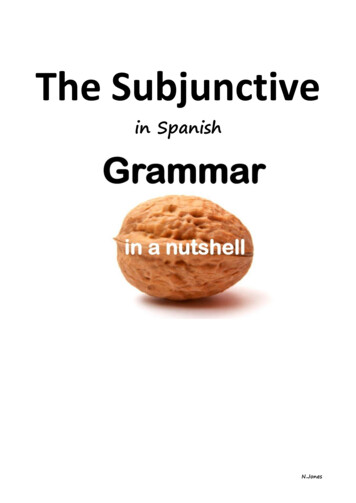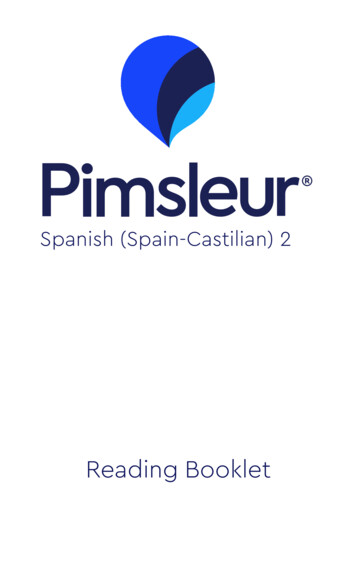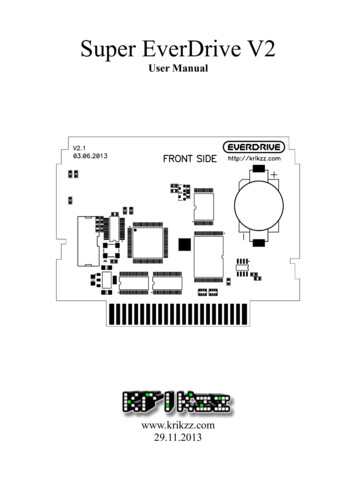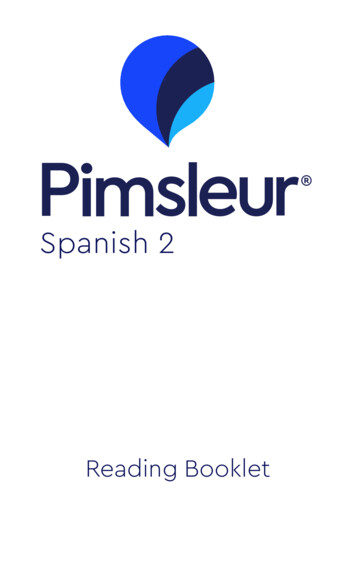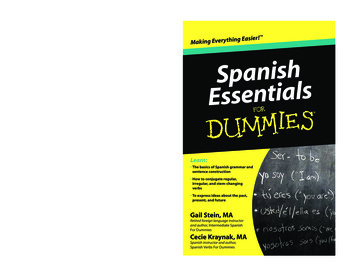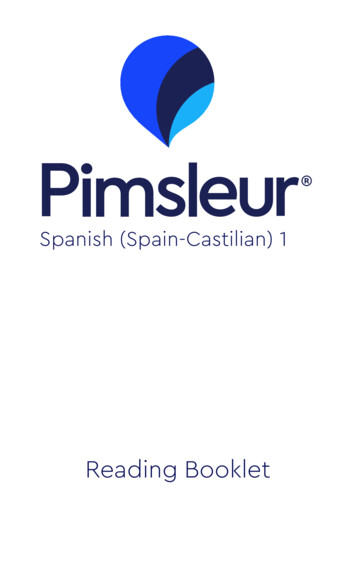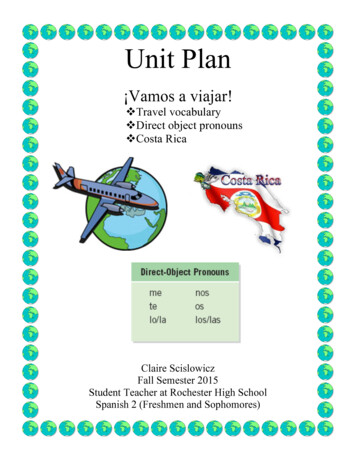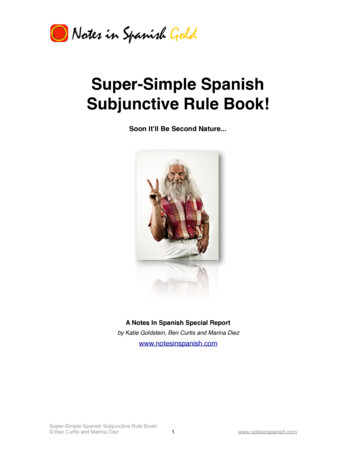
Transcription
!Super-Simple SpanishSubjunctive Rule Book!Soon It’ll Be Second Nature.A Notes In Spanish Special Reportby Katie Goldstein, Ben Curtis and Marina Diezwww.notesinspanish.comSuper-Simple Spanish Subjunctive Rule Book! Ben Curtis and Marina Diez1!www.notesinspanish.com
!We Already Know The Subjunctive! .3Ben’s Big Subjunctive Secret - Please Read! .3Ummm. Aren’t there any rules? Yes! BUT: .5A Quick Note On Forming The Subjunctive .6For Acronym Fans .7Our Super-Simple Spanish Subjunctive Rules.8Rule 1: The Subjunctive After ‘Que’ .8Rule 2: Emphatic Expressions (Commands and Desires) .10Rule 3: With Imperatives And Usted and Ustedes .11Rule 4. Required With Certain Conjunctions .11Rule 5: When NOT To Use The Subjunctive .12Rule 6: When To Use Present And Present Perfect Subjunctive, Or TheImperfect Subjunctive .13Rule 7: Non-existence! .14Rule 8: Aunque - A Tricky Conjunction .16Rule 9: Time expressions .16Rule 10: Conditionals .19Rule 11: Comparative Conditional Sentences .20Rule 12: Como .20A Note About Ojalá .20Cool Stuff and Expressions .21And Finally, Thanks!.21Super-Simple Spanish Subjunctive Rule Book! Ben Curtis and Marina Diez2!www.notesinspanish.com
!We Already Know The Subjunctive!If there’s one thing that drives Spanish learners to distraction, or better still, hasthem trembling in their boots, at any level. it’s our good friend The Subjunctive.Most people don’t want to know anything about it, and who can blame them? Aren’tthere enough NORMAL verb tenses to learn without complicating things evenfurther?It’s not as if we have to deal with it in English! .Or do we?Yes we do! We just don’t know it: If I were rich I’d live in Barcelona. - there’s aSubjunctive in that sentence that English speakers use all the time!I wish it were sunny. There’s another subjunctive!These hypothetical subjunctive clauses are present in English and common in alllanguages. It just goes to show that our brains already know how to process, feel,and express a little bit of subjunctive already!Knowing that our brains are already set up for the subjunctive is the key to Ben’sBig Subjunctive Secret, which we’ll get onto right now.Ben’s Big Subjunctive Secret - Please Read!As well as all of the usual tenses in Spanish (present, future, imperfecto, pretéritoetc), there are also two Moods (also called Voices): the Indicative, and theSubjunctive.I (Ben) was taught a secret way to help you know exactly when to use each mood,by one of my first Spanish teachers in Spain, a crazy Argentinian lady calledLiliana.Liliana’s clever ‘illustration’ of the subjunctive changed the way I was able to thinkabout it, and learn it, forever. I hope it helps you too.The Secret:It’s simple. Liliana told us that the Indicative Mood handles most everydaysituations. It’s a normal, businesslike, straightforward kind of a mood, for normal,Super-Simple Spanish Subjunctive Rule Book! Ben Curtis and Marina Diez3!www.notesinspanish.com
!straightforward talk about what’s real, and what’s either going on right now, ordefinitely going to happen without a doubt.Liliana drew a picture on the board for us, of a business man, and told us that as aperson, the Indicative looks a bit like this, Mr. Straightforward, a regular guy:You know all about the Indicative already - you’ve been learning these nice,businesslike indicative verb tenses since Day 1.Next, Liliana drew another person on the board, and told us that if the subjunctivemood were a person, (and here’s the secret!) he’d look like this:That’s right! The subjunctive, she said, is a spaced-out hippie, lodging happily in aworld of unreality and uncertainty, always subjectively giving his hippieinterpretation of reality and emotions, philosophizing all day long abouthypothetical and interesting things that probably haven’t happened yet!Super-Simple Spanish Subjunctive Rule Book! Ben Curtis and Marina Diez4!www.notesinspanish.com
!Indicative Mr. Normal . Subjunctive Hippie DudeSeeing it like that did something to my brain that changed the way I thought about,and knew when to use, the subjunctive forever afterwards.These days, when I notice that the next Spanish sentence coming out of my mouth‘feels a little bit hippie’, I just dive in and use the subjunctive, and nine times out often, I get it right!Just remember to think like that. If the situation, feeling, or thing you want toexpress feels a little bit ‘off-center’, ‘ hippie’, or slightly disconnected with reality,then try throwing in a subjunctive. Works a treat ;)Ummm. Aren’t there any rules? Yes! BUT:OK, all that hippie stuff is helpful (I promise!), but like all grammar, there are somerules that help you find your way through the subjunctive labyrinth.This report brings you the most important, and largely simple rules that you need,as you press on in your mission to Total Spanish Fluency, BUT:BUT 1:Apart from the principal, most important rules listed below, there are still otherminor subjunctive rules in Spanish that not even the Spanish know!And guess what, they aren’t bothered by that fact! .So neither should you be!Native Spanish speakers have just developed the subjunctive corner of their brainsto a high degree, just as you will develop your subjunctive sixth sense as well overtime!BUT 2:For some of the rules, there is a ‘matiz’ - a twist on the rule for a very specificsituation or set of circumstances, where the rule goes out of the window.We’ll discuss some of these, but not all of them. as each of us only has limitedtime on this earth, and there isn’t enough of it to cover all the matices connectedwith the subjunctive!Super-Simple Spanish Subjunctive Rule Book! Ben Curtis and Marina Diez5!www.notesinspanish.com
!The thing is though, that once you know the rules below, and once you recognizethe hippie, other-worldly aspect of the Subjunctive discussed above (and as longas you’ve learned your subjunctive verbs tenses!), the subjunctive will eventuallybecome second nature.It will appear perfectly formed in your mouth when it should, without you eventhinking about it. With time (and this is based on my personal experience) I canpromise you that.- BenP.S. The number of rules and examples below can look totally overwhelming.Please, don’t feel pressured or rushed to learn too much subjunctive, too quickly.All the rules below might typically be taught over the space of a year or two in anormal class, so take your time, and keep having fun with the everyday, indicativeside of Spanish for now, incorporating that hippie subjunctive stuff just a little at atime!A Quick Note On Forming The SubjunctiveThe Subjunctive mood is primarily used in the following three tenses: the presentsubjunctive, the present perfect subjunctive, and the imperfect subjunctive.Here’s an example of each (note, all the subjunctives in examples in this reportare highlighted in bold):Present SubjunctiveEs importante que estudies - It’s important that you studyPresent Perfect SubjunctiveMe alegro de que hayas venido - I’m really glad you cameThe Imperfect SubjunctiveSi hablara español mejor, no tendría que ir a clase - If I spoke Spanish better, Iwouldn’t have to go to classSuper-Simple Spanish Subjunctive Rule Book! Ben Curtis and Marina Diez6!www.notesinspanish.com
!This special report concerned with the rules you need to know for when to use thesubjunctive, so we are not going to spend time now on how to form every singlesubjunctive tense, or list every single verb/mood/tense combination of every singleverb! You already have a good Spanish verb book for that, right?If not, and you need to brush up on how to form the subjunctive, then I highlyrecommend these two excellent webpages from Indiana University:1. Forms of the Present JFRMS.HTM2. More Subjunctive Tenses (Present Perfect, Imperfect TMFor Acronym FansHow to remember the irregular present subjunctives.Here’s a good way to remember which verbs are unkind enough to becomeirregular in the present subjunctive, easy for acronym lovers! You do the DISHES:Dar. dé,des etcIr. vaya,vayas etcSaber. sepa,sepas etcHaber.haya,hayas etcEstar. esté,estés etcSer.sea,seas. etcOK, time to get down to our Super-Simple Spanish Subjunctive Rules.Read on below!Super-Simple Spanish Subjunctive Rule Book! Ben Curtis and Marina Diez7!www.notesinspanish.com
!Our Super-Simple Spanish Subjunctive RulesRule 1: The Subjunctive After ‘Que’The subjunctive frequently follows ‘que’, and is used after verbs that express:A. Wishes, hopes, and desires (For example: esperar que, desear que, quererque)Quiero que vengas - I want you to comeEspero que vayas - I hope you goB. Disbelief, doubt, and denial (For example: no creer que, dudar que, negarque)No creo que sea verdad - I don’t think it’s trueDudo que venga - I doubt that he’ll comeNiego que ella estuviera allí - I deny that she was thereC. Possibility and hypothesis (For example: ser posible que, ser probableque)Es posible que vengan - It's possible they'll comeEs probable que vaya - It’s likely that I’ll goD. Requests and commands (For example: pedir que, decir que, exigir que)Te pido, por favor, que me vengas a buscar esta tarde - I’m asking you to comeand collect me this afternoonDigo que no llegues tarde - I ask that you don’t get back lateSuper-Simple Spanish Subjunctive Rule Book! Ben Curtis and Marina Diez8!www.notesinspanish.com
!Te exijo que me trates con respeto - I demand that you treat me with respectE. Opinions with adjectives and adverbs (For example: es fantástico que, esuna vergüenza que, es injusto que, es bueno que, es malo que, está bienque, está mal que, el hecho de que)Es importante que estudies - It’s important that you studyEs normal que vengan - It’s normal that they comeEl hecho de que vuelvas a trabajar es una buena noticia - The fact that you aregoing back to work is good newsF. Obligations and suggestions with adjectives and adverbs (For example: Esmejor que, hace falta que, es necesario que, aconsejo que, recomiendo que)Es mejor que te vayas - It'd be better for you to goHace falta que aprendas más - You need to learn moreEs necesario que vuelvas - It’s necessary that you returnTe aconsejo que tengas cuidado - I advise you to be carefulTe recomiendo que te levantes pronto - I recommend that you get up earlyG. Emotional reactions (For example: siento que, lamento que, me gusta que,me alegro (de) que, me extraña que, me sorprende que, tengo miedo (de)que)Siento que no quieras venir - I'm sorry you don't want to comeMe gusta que ella me ayude - I like it that she helps meMe alegro (de) que te guste - I’m happy that you like itMe extraña que no hayan aparecido - It’s strange that they haven’t shown upSuper-Simple Spanish Subjunctive Rule Book! Ben Curtis and Marina Diez9!www.notesinspanish.com
!Me molesta que te llamen fuera de horas de trabajo - It bothers me that they callyou outside working hoursH. “Negation of perception” (For example: No veo que, no digo que, no meacuerdo que, no noto que)No veo que me ayudes - I don’t see that you’re helping meNo digo que sea verdad - I’m not saying that it’s trueNo me acuerdo de lo que me dijeron - I don’t remember what they told meNo noto que estén tristes - I can’t tell that they’re sad Rule 2: Emphatic Expressions (Commands and Desires)First up, we have the negative imperative commands in the informal tu andvosotros forms (basically, telling people you know well not to do something!):¡No te vayas! / ¡No os vayais! - Don't go!¡No digas eso! / ¡No digáis eso! - Don't say thatAnd secondly, the shortened wishes and desires that are usually deliveredenergetically, in a quick burst of speech, after a Que:¡Que tengas un buen día! - Have a good day!¡Que lo pases bien! - Have a good time!¡Que aproveche! - Enjoy your meal!¡Que te vayas! - Leave already/Get out!¡Ojalá (que) nieve este año! - Hopefully it will snow this year!Super-Simple Spanish Subjunctive Rule Book! Ben Curtis and Marina Diez! 10www.notesinspanish.com
!Rule 3: With Imperatives And Usted and UstedesWhen we us the usted and ustedes form to address someone formally, asubjunctive is necessary when issuing commands (basically, telling people youdon’t know well to do something):¡Ponga sus manos encima de la mesa! - Put your hands on the table! (Delivered tosomeone you would address as Usted)¡Salgan por la puerta principal por favor! - Leave by the main door please! (Said toa group of people you would address asUstedes) Rule 4. Required With Certain ConjunctionsCertain conjunctions are always followed by the subjunctive in Spanish, startingwith this one, that you are likely to use most:- Para que (so that)Es para que no te olvides - It's so that you don't forget- Sin que (without)Vamos a entrar sin que nos vean - We'll go in without them seeing us- A menos que (unless)Iremos a menos que nos digan que no - We’ll go unless they tell us not toSuper-Simple Spanish Subjunctive Rule Book! Ben Curtis and Marina Diez!11www.notesinspanish.com
!- Con tal de que (as long as)Me da igual a que restaurante ir con tal de que quedemos a cenar - I don’t carewhich restaurant we go to as long as wemeet for dinner Rule 5: When NOT To Use The SubjunctiveTrue statements do not take the subjunctive in affirmative sentences or questions,but DO take it in the negative form:For example, with the verb creer:Affirmative (Indicative): Creo que va a llover - I think it’s going to rainQuestion (Indicative): ¿Crees que va a llover? - Do you think it’s going to rain?Negative (with subjunctive): No creo que vaya a llover - I don’t think it’s going torain.This rule applies to all the following sets of verbs:creer/pensar/opinar que - to think/believe thatsuponer que - to suppose thates evidente que - it's evident thatestá claro que - it's clear thates cierto que/es verdad que - it's true thates que - it's thatsucede/ocurre que - what's going on is thatparece que - it seems thatSuper-Simple Spanish Subjunctive Rule Book! Ben Curtis and Marina Diez! 12www.notesinspanish.com
!está demostrado que - it's shown thatresulta que - it turns out that(es) seguro que - surelyes obvio que - it’s obvious thatAlso, the following two constructions do not take the subjunctive, even thoughthey look like they deserve one:No cabe duda de que - there's no doubt thatNo cabe duda de que tienes razon - there is no doubt that you are rightMenos mal que - Thank goodness thatMenos mal que vivimos en España - Thank goodness we live in SpainAlso DO NOT use the subjunctive (even though your brain feels like it should.)after the expressions a lo mejor and seguramente. Leave the verb in theindicative:A lo mejor están aquí - Perhaps they're here (están Indicative)Seguramente me lo merezco - I’m sure I deserve it (merezco Indicative) Rule 6: When To Use Present And Present Perfect Subjunctive, OrThe Imperfect SubjunctiveA. If the first verb is in the present, present perfect, future, or imperative, thesecond (dependent) verb will usually be in the present subjunctive or the presentperfect subjunctive:Super-Simple Spanish Subjunctive Rule Book! Ben Curtis and Marina Diez! 13www.notesinspanish.com
!Quiero que vengas - I want you to come (present subjunctive)Ella querrá que vayamos - She'll want us to go (present subjunctive)Habla para que te oigan - Speak so that they hear you (present subjunctive)Dudo que haya comido ya - I doubt she’s eaten already (present perfectsubjunctive)Me alegro de que hayas disfrutado del video - I’m delighted that you enjoyed thevideo (present perfect subjunctive)B. If the first verb is in any past tense or a conditional, the second verb will usuallybe in the imperfect subjunctive.Me sorprendió que él no hablara inglés - It surprised me that he didn’t speakEnglish (imperfect subjunctive)Me gustaría que vinieras - I'd like you to come (imperfect subjunctive) Rule 7: Non-existence!The subjunctive gets a bit trickier in situations where you have to consider thespeaker’s attitude toward, certainty, or knowledge about, whatever he/she is talkingabout.Less knowledge or certainty about something, for example, will often mean usingthe subjunctive.Context is important here, as is the different meaning you can convey by usingsubjunctive, rather than indicative. Confused? Don’t worry, here comes anexample!The truth about non-existence!We use the subjunctive when we don’t specify, or are not sure, if a certain person,place, or thing exists. If you are sure the thing exists, you can use the indicative.Imagine I want to buy a T-Shirt with a photo of Elvis on it, so I walk into a T-Shirtshop and say one of the following two things:Super-Simple Spanish Subjunctive Rule Book! Ben Curtis and Marina Diez! 14www.notesinspanish.com
!Busco una camiseta que lleva una foto de Elvis (lleva indicative)Busco una camiseta que lleve una foto de Elvis (lleve subjuncive)Both sentences mean the same: I am looking for a T-Shirt with a photo of Elvison.BUT, in the first sentence I use the Indicative, because I KNOW that this shop hassuch a T-Shirt, because I saw it there last week. Prior knowledge makes me feelsolidly indicative.But in the second sentence I don’t know whether this shop has such a T-Shirt ornot - and all that hopeful uncertainty, or lack of prior knowledge, brings out thesubjunctive in me!More subjunctive examples of the non-existence principle:Busco una persona que sea responsable - I’m looking for a person who isresponsible (but I don’t have anyone inmind, hence subjunctive)Busco unos zapatos que sean cómodos y no muy caros - I’m looking for someshoes that are comfortable and not veryexpensive (Not sure if you have any.)Quiero vivir en una ciudad que tenga buen transporte público - I want to live in acity that has good public transport (I don’tknow any)Pararemos donde podamos - We’ll stop where we can (not sure where yet)No hay nadie aquí que tenga una casa en la playa - There’s no one here who hasa house at the beach (no one meets thecriteria non-existence)Cualquier cosa que compres les va a gustar - Whatever you buy, they’re going tolike (the gift still hasn’t been decidedyet)Super-Simple Spanish Subjunctive Rule Book! Ben Curtis and Marina Diez! 15www.notesinspanish.com
!Rule 8: Aunque - A Tricky Conjunction'Aunque' (even though) can be used with the indicative or subjunctive; it dependson if what you're saying is a fact, or if it's not yet a fact, respectively.You can think of this as if you are using 'aunque' to say 'although' or 'eventhough' (indicative) or if you're using it to say 'even if' (subjunctive):Aunque me gusta, no lo voy a comprar - Even though I like it, I'm not going to buy it(verb in indicative)Aunque me gustara, no lo compraría - Even if I liked it, I wouldn't buy it (verb insubjunctive)Me gusta el azul aunque prefiero el verde - I like the blue one although I prefer thegreen one (verb in indicative)Iré aunque esté muy cansada - I'll go even if I'm very tired (verb in subjunctive) Rule 9: Time expressionsWith time expressions like cuando (when) and en cuanto que (as soon as), we usethe subjunctive when the action hasn’t happened or been completed yet, and theindicative for things that have already happened.Here are two examples that shows this in action:Subjunctive:Entramos cuando la gente deje de aplaudir - We'll go in when people stopclappingIndicative:Entramos cuando la gente dejó de aplaudir - We went in when people stoppedclappingSuper-Simple Spanish Subjunctive Rule Book! Ben Curtis and Marina Diez! 16www.notesinspanish.com
!Subjunctive:En cuanto que lo haya hecho, te lo diré - As soon as I've done it, I'll tell youIndicative:En cuanto (que) salieron del barco, buscaron un bar - As soon as they got off theboat, they looked for a barMore time expressions that work like ‘En Cuanto Que’:Apenas, nada más que, and tan pronto como also mean ‘as soon as’ whenfollowed by a verb (you can replace ‘En cuanto que’ with any of these in theexample above.)And some MORE important time expressions.Below are five more important time expressions that use the subjunctive when theaction hasn’t happened or been completed yet, and the indicative for things thathave already happened:1. Desde que - SinceSubjunctive:Desde que empiece la película no quiero oiros hablar - Once the film has started,I don’t want to hear you talkingIndicative:Desde que empecé a hacer yoga no me ha vuelto a doler la espalda - Since Istarted doing yoga, my back hasn’tached again2. Después (de) que - afterSubjunctive:Super-Simple Spanish Subjunctive Rule Book! Ben Curtis and Marina Diez! 17www.notesinspanish.com
!Después de que comamos me voy al parque a dar un paseo - After we’ve eatenI’m going for a walk in the parkIndicative:Después de que llegué al cine no había entradas - After I got to the cinema therewere no tickets left3. Hasta que - untilSubjunctive:No voy a ir al Museo del Prado hasta que vengas a Madrid - I’m not going to thePrado museum until you come to MadridIndicative:No me tomo un café hasta que llego al trabajo - I don’t have a coffee until I get towork4. Mientras que - whileSubjunctive:Mientras que dejes de fumar no me importa que tomes chicle - While you stopsmoking I don’t mind that you chew gumIndicative:Mientras que voy en el coche voy aprendiendo español - While I’m in the car Ilearn Spanish5. Siempre que - every time/wheneverSubjunctive:Siempre que vengas a Madrid, ven a vernos - Whenever you come to Madrid,come and see usIndicative:Super-Simple Spanish Subjunctive Rule Book! Ben Curtis and Marina Diez! 18www.notesinspanish.com
!Siempre que voy a Madrid, voy a verles - Every time I go to Madrid I go to seethemN.B. Antes de que (before) always takes the subjunctive:Llámame antes de que te vayas - Call me before you go Rule 10: ConditionalsFor ‘if’ conditionals (with si) you use the indicative for likely conditions in thepresent or the future:Si viene, dormirá aquí - If he comes, he'll sleep here (all in the indicative).But you use the subjunctive for hypothetical, unlikely, or impossible conditions inthe past, present, or future. Hint: If your sentence has ‘would’ somewhere in it inEnglish, you’ll probably use the imperfect subjunctive in Spanish.Here are some examples of hypothetical ‘if’ sentences with ‘would’ that take theimperfect subjunctive:Si fuera rico, viajaría por todo el mundo - If I were rich, I'd travel all over the worldSi tuviera un coche, podría evitar el Metro - If I had a car, I could avoid the MetroAnd here are two examples where we talk about something that could, or might,have happened in the past, and use the pluperfect subjunctive:Si me lo hubieras dicho, no habría ido - If you had told me, I wouldn't have goneSi no hubiera venido a España, me habría ido a Francia - If I hadn’t come toSpain, I’d have gone to FranceNote 1: You NEVER use the present subjunctive after ‘si’ (if) in Spanish.Note 2: Do you know what the Spanish is for ‘Pluperfect Subjunctive?’.Super-Simple Spanish Subjunctive Rule Book! Ben Curtis and Marina Diez! 19www.notesinspanish.com
!Pluscuamperfecto de Subjuntivo! Try saying that fast five times in a row!Rule 11: Comparative Conditional SentencesYou also use the imperfect subjunctive in comparative conditional sentences withcomo si and igual que si:Me trata como si fuera una niña - He treats me like I’m a little girlMe habla igual que si fuera idiota - He talks me as if I were an idiot Rule 12: ComoWe can use como in the indicative or the subjunctive, depending on what we wantto say:Subjunctive:Como se retrasen, nos vamos - If they get delayed, we’ll leave(We aren’t sure if they’re arriving or not, this is a conditional situation)Indicative:Como se retrasan, nos vamos - Since they’re delayed, we’re going to leave(We already know they’re not arriving, they rang to say that they are delayed)A Note About OjaláIf we use the expression ‘ojalá’ followed by present subjunctive, we believesomething is a possibility:¡Ojalá (que) haya entradas todavía! - Hopefully there are still tickets!Super-Simple Spanish Subjunctive Rule Book! Ben Curtis and Marina Diez! 20www.notesinspanish.com
!But if we use it with the imperfect subjunctive, we think it’s impossible/improbable:¡Ojalá (que) fuera rico! - If only I were rich!Cool Stuff and ExpressionsBelow are some common phrases and expressions that you often hear in Spain,that use the subjunctive. Using any of these appropriately will make you soundSuper-Spanish!Note: We can’t guarantee these will all work in Latin/South America.!Tengo una movida en casa que no veas! - Everything is crazy at home! (usuallynegative, e.g. because my son is ill/myhusband has lost his job)¡Que te vaya todo muy bien! - I hope everything goes well / Good luck!¡Que te mejores! - Get well soon!¡Que sueñes con los angelitos! - Sweet dreams! (Literally, I hope you sleep/dreamwith the angels!)¡Que te cunda mucho! - I hope you get lots of work done!¡Que me dejes en paz! - Leave me alone/in peace!¡Maldita sea! - Damn it!¡Que se besen! - Kiss each other! (Shouted to the bride and groom during thebanquet at Spanish weddings!)And Finally, Thanks!Huge thanks go to Katie (who many of you will know through her invaluable helpwith our support system), for her many hours of research for this special report.Super-Simple Spanish Subjunctive Rule Book! Ben Curtis and Marina Diez! 21www.notesinspanish.com
!Katie has been living and teaching in Spain for many years, and uses thesubjunctive like one of the locals - it was still hard work to organize it all so well onpaper though!Thanks Katie!- Ben and Marina, Notes in SpanishSuper-Simple Spanish Subjunctive Rule Book! Ben Curtis and Marina Diez! 22www.notesinspanish.com
straightforward talk about what’s real, and what’s either going on right now, or definitely going to happen without a doubt. Liliana drew a picture on the board for us, of a business man, and told us that as a person, the Indicative looks a bit like this, Mr. Straightforward, a regular guy: You know all about
